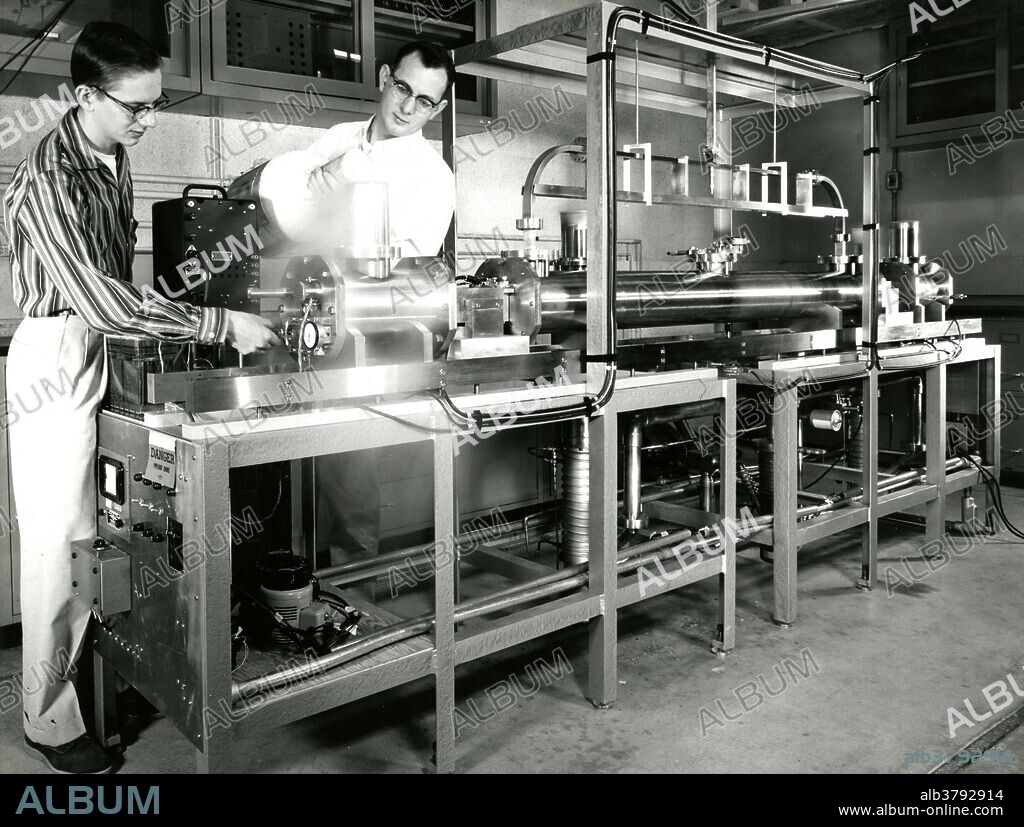alb3792914
NBS-2, NIST Atomic Clock

|
Add to another lightbox |
|
Add to another lightbox |



Title:
NBS-2, NIST Atomic Clock
Caption:
In 1952, NIST completed the first accurate measurement of the frequency of the cesium clock resonance. The apparatus for this measurement is named NBS-1. In 1955, the National Physical Laboratory in England built the first cesium-beam clock used as a calibration source. In 1959, the NBS-1 went into regular service as NIST's primary frequency standard. In 1960, NBS-2 was inaugurated in Boulder; it could run for long periods unattended and was used to calibrate secondary standards. It was one of the two cesium beam frequency standards that were in operation, making it possible to refer the national standard of frequency to an atomic resonance. It was accurate to within 1.5 parts in 10. Charles Snider of the Radio Standards Laboratory pours liquid nitrogen over a cold trap of the new cesium beam frequency standard as Roger Beehler adjusts the atomic beam detector. The U-shaped resonant cavity used to excite the cesium transition is suspended above the center of the machine. An atomic clock is a clock device that uses an electronic transition frequency in the microwave, optical, or ultraviolet region of the electromagnetic spectrum of atoms as a frequency standard for its timekeeping element. Atomic clocks are the most accurate time and frequency standards known, and are used as primary standards for international time distribution services, to control the wave frequency of television broadcasts, and in global navigation satellite systems such as GPS.
Personalities:
Credit:
Album / NIST/Science Source
Releases:
Model: No - Property: No
Rights questions?
Rights questions?
Image size:
4200 x 3176 px | 38.2 MB
Print size:
35.6 x 26.9 cm | 14.0 x 10.6 in (300 dpi)
Keywords:
1960 • 1960S • 20 XX TWENTIETH CENTURY • 20TH CENTURY • 20TH • 60 60'S DECADE SIXTY YEARS • 60 60'S DECADE YEARS SIXTY SIXTIES • 60S • ACCURACY • ACCURATE • APPARATUS • ATOMIC CLOCK • ATOMIC PHYSICS • BW • CAESIUM ATOMIC CLOCK • CAESIUM BEAM CLOCK • CAESIUM STANDARD • CAESIUM • CESIUM ATOMIC CLOCK • CESIUM BEAM CLOCK • CESIUM STANDARD • CESIUM • CLOCK • DEVICE • FREQUENCY STANDARD • INSTRUMENT • MACHINE • MEASURE TIME • MEN • METROLOGY • NATIONAL BUREAU OF STANDARDS • NATIONAL INSTITUTE OF STANDARDS AND TECHNOLOGY • NBS • NBS-2 • NIST • PHOTO • PHOTOGRAPH • PHYSICS • PRECISION • SCIENCE OF MEASUREMENT • SCIENCE • SECONDARY STANDARDS • SIXTIES • SIXTIES, THE • STABLE • TECHNICIANS • TECHNOLOGICAL • TECHNOLOGY • TIME KEEPING • TIME • TIME-MEASURING • TIMEKEEPING • TWENTIETH CENTURY • YEARS DECADE'S SIXTY SIXTIES 60 60 1960
 Pinterest
Pinterest Twitter
Twitter Facebook
Facebook Copy link
Copy link Email
Email

